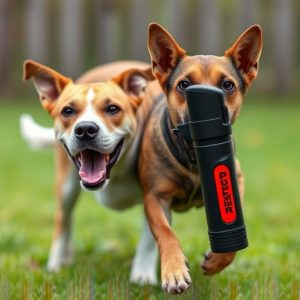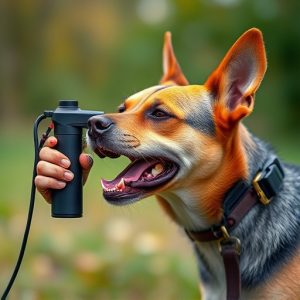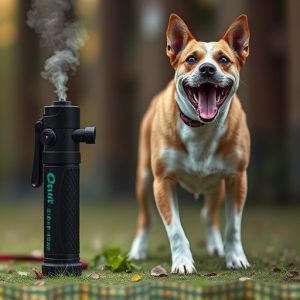Runner’s Defense Dog Deterrent Spray: Active Ingredients, Safety & Legal Use
Dog repellent sprays are popular among runners seeking non-lethal protection against canine interact…….
Dog repellent sprays are popular among runners seeking non-lethal protection against canine interactions, with effectiveness stemming from carefully selected active ingredients that mask human scents and introduce unappealing odors to dogs. Key substances like capsaicin and synthetic irritants trigger unpleasant sensations in dogs' sensitive areas, ensuring immediate and lasting impact. Optimal usage involves applying these sprays along frequent canine encounter zones, maintaining regular reapplication after rainfall or dryness. Understanding legal constraints and responsible usage is crucial, as regional regulations vary regarding ingredient potency and application guidelines.
Runners and outdoor enthusiasts, meet your new secret weapon: Dog Deterrent Spray. This innovative solution offers a safe and effective way to protect yourself from aggressive canine encounters. In this comprehensive guide, we’ll explore the science behind these sprays, focusing on the active ingredients that make them powerful deterrents. We’ll also uncover common chemicals used in products like Runner’s Defense, providing insights into their efficacy and safety. Prepare to learn the dos and don’ts of application and navigate legal considerations for responsible use.
- Understanding Dog Deterrent Sprays: Benefits and Safety
- The Role of Active Ingredients in Efficacy
- Common Chemicals Used in Runner's Defense Dog Spray
- Application Techniques for Optimal Results
- Legal Considerations and Responsible Use
Understanding Dog Deterrent Sprays: Benefits and Safety
Dog deterrent sprays have gained popularity as an effective and non-lethal way to protect runners from unwanted canine encounters. Understanding what goes into these repellents is key to ensuring their safety and efficacy. The active ingredients in dog repellent spray play a crucial role in deterring dogs, often using scent-based formulas that canines find repulsive. These ingredients are carefully selected for their ability to mask human scents while introducing odors that dogs naturally avoid, thereby discouraging approaches.
While these sprays offer numerous benefits, safety should never be overlooked. Repellents designed for dogs should be pet-friendly and non-toxic to humans. Users must follow application instructions carefully to maximize effectiveness without causing harm. By choosing products with well-researched active ingredients, runners can enjoy enhanced safety during their outdoor activities while minimizing potential risks associated with chemical exposure.
The Role of Active Ingredients in Efficacy
The effectiveness of a dog deterrent spray largely hinges on the quality and potency of its active ingredients. These key components are designed to trigger an unpleasant sensory experience for dogs, deterring them from approaching or lingering in treated areas. Common active substances include capsaicin, which is derived from chili peppers, and synthetic analogs of natural irritants that can mimic the sensation of a chemical burn. The concentration and delivery system of these active ingredients play a crucial role in ensuring their immediate and lasting impact on canine behavior.
Choosing a dog repellent spray with well-formulated active ingredients is essential for optimal results. A high-quality product will use concentrated formulations that are specifically tailored to target the dog’s sensitive areas, such as eyes, nose, and paws. This strategic approach enhances the spray’s ability to disrupt and discourage unwanted behavior, making it an effective tool for runners seeking to protect their paths from canine intruders.
Common Chemicals Used in Runner's Defense Dog Spray
Dog deterrent sprays designed for runners often contain a blend of active ingredients tailored to effectively keep dogs at bay without causing them harm. Common chemicals include capsaicin, a compound found in chili peppers that triggers a mild but unpleasant irritation in a dog’s nose and eyes, making them less likely to approach. Another prevalent ingredient is citronella oil, known for its strong scent that many dogs find repulsive.
Some formulations also incorporate ultraviolet (UV) tracers, which are invisible to the naked eye but can be detected by dogs’ sensitive noses. These tracers help identify areas where dogs have been and can guide runners in avoiding these paths. Additionally, certain brands use natural components like black pepper or garlic extracts as active ingredients, leveraging their strong odors to deter canine intruders.
Application Techniques for Optimal Results
For optimal results with dog deterrent spray, understanding application techniques is key. The primary active ingredients in these sprays, such as capsaicin or citronella, need to come into direct contact with the dog’s sense of smell and skin to be effective. Therefore, when applying the spray, target areas where dogs are most likely to encounter and interact with, like paths, fences, and entryways.
For best practice, apply the spray in short bursts at regular intervals along the perimeter of your designated area. This ensures a consistent concentration of active ingredients, making it more difficult for dogs to build up tolerance. Regular reapplication is also crucial, especially after rainfall or when the spray dries out, to maintain an effective barrier that deters canine intruders.
Legal Considerations and Responsible Use
When considering a runner’s defense dog deterrent spray, it’s crucial to understand the legal considerations and responsible use guidelines. The effectiveness of such sprays relies on their active ingredients, which can vary widely in composition and potency. It’s important to note that many dog repellent sprays contain capsaicin, the active ingredient found in chili peppers, or other natural or synthetic substances designed to deter canine aggression without causing harm.
However, regulations regarding these products differ across regions. Some areas have strict rules on the sale and use of dog deterrent sprays, including restrictions on the strength of active ingredients and requirements for proper labeling and packaging. Runners using such sprays must adhere to local laws and ensure responsible application, typically avoiding directions that could cause unnecessary suffering or distress to animals. Responsible use also includes keeping the spray out of reach of children and pets when not in use and disposing of it properly to prevent environmental contamination.
Dog deterrent sprays, like those formulated by Runners Defense, offer a safe and effective solution for runners facing dog encounters. By understanding the role of active ingredients, common chemicals, application techniques, and legal considerations, users can maximize their protection while ensuring responsible use. These sprays provide peace of mind, allowing runners to enjoy their outdoor activities without the worry of unwanted canine interactions. Remember, proper usage and awareness are key to a successful and safe experience.


